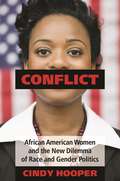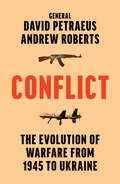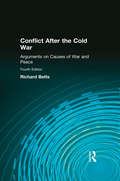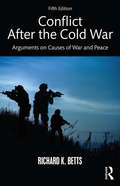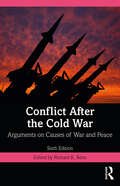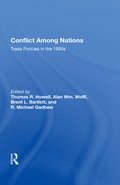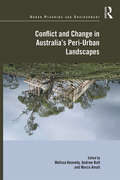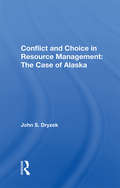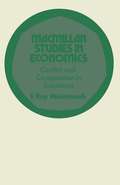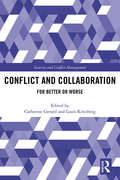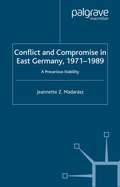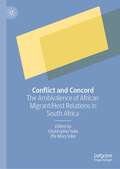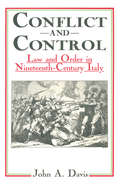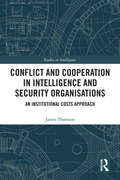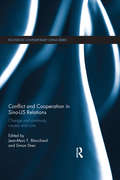- Table View
- List View
Conflict: African American Women and the New Dilemma of Race and Gender Politics
by Cindy HooperThis in-depth examination looks at African American women's navigation of the interlocking obstacles of race and gender specifically within the political arena.Conflict: African American Women and the New Dilemma of Race and Gender Politics offers a provocative examination of an increasingly important voting bloc, one that impacted the 2008 election and whose loyalties will have far-reaching implications for future contests. This fascinating study is three-pronged. It explores the conflicts African American women experience in prioritizing race over gender, offers data-backed analysis of the substantial power of this bloc to influence elections, and looks at the ways in which the very existence of that influence impacts the political and social empowerment of this dual-identity population.As background to the present-day story, the book surveys the history of African American females in elective office in the United States, as well as their roles in the Women's Suffrage and Civil Rights movements. The first work to undertake a study of African American women in this expansive political context, this important volume will help readers assess where African American women have been, where they are now, and what their roles might be in the future.
Conflict: African American Women and the New Dilemma of Race and Gender Politics
by Cindy HooperThis in-depth examination looks at African American women's navigation of the interlocking obstacles of race and gender specifically within the political arena.Conflict: African American Women and the New Dilemma of Race and Gender Politics offers a provocative examination of an increasingly important voting bloc, one that impacted the 2008 election and whose loyalties will have far-reaching implications for future contests. This fascinating study is three-pronged. It explores the conflicts African American women experience in prioritizing race over gender, offers data-backed analysis of the substantial power of this bloc to influence elections, and looks at the ways in which the very existence of that influence impacts the political and social empowerment of this dual-identity population.As background to the present-day story, the book surveys the history of African American females in elective office in the United States, as well as their roles in the Women's Suffrage and Civil Rights movements. The first work to undertake a study of African American women in this expansive political context, this important volume will help readers assess where African American women have been, where they are now, and what their roles might be in the future.
Conflict: The Evolution Of Warfare From 1945 To Ukraine
by David Petraeus Andrew Roberts‘A HUGELY IMPORTANT BOOK … ELEGANTLY WRITTEN AND PERSUASIVELY ARGUED’ DAILY TELEGRAPH, FIVE-STAR REVIEW ‘AN INTELLIGENT, AUTHORITATIVE, COMPELLING AND, ABOVE ALL, TIMELY' TLS Shortlisted for the Military History Matters Book of the Year Award
Conflict After the Cold War: Arguments on Causes of War and Peace
by Richard K. BettsEdited by one of the most renowned scholars in the field, Richard Betts' Conflict After the Cold War assembles classic and contemporary readings on enduring problems of international security. Offering broad historical and philosophical breadth, the carefully chosen and excerpted selections in this popular reader help students engage key debates over the future of war and the new forms that violent conflict will take. Conflict After the Cold War encourages closer scrutiny of the political, economic, social, and military factors that drive war and peace.
Conflict After the Cold War: Arguments on Causes of War and Peace
by Richard K. BettsEdited by one of the most renowned scholars in the field, Richard Betts' Conflict After the Cold War assembles classic and contemporary readings on enduring problems of international security. Offering broad historical and philosophical breadth, the carefully chosen and excerpted selections in this popular reader help students engage key debates over the future of war and the new forms that violent conflict will take. Conflict After the Cold War encourages closer scrutiny of the political, economic, social, and military factors that drive war and peace.
Conflict After the Cold War: Arguments on Causes of War and Peace
by Richard K. BettsEdited by one of the most renowned scholars in the field, Richard Betts' Conflict After the Cold War assembles classic and contemporary readings on enduring problems of international security. Offering broad historical and philosophical breadth, the carefully chosen and excerpted selections in this popular reader help students engage key debates over the future of war and the new forms that violent conflict will take. Conflict After the Cold War encourages closer scrutiny of the political, economic, social, and military factors that drive war and peace. New to the Fifth Edition: Original introductions to each of 10 major parts as well as to the book as a whole have been updated by the author. An entirely new section (Part IX) on "Threat Assessment and Misjudgment" explores fundamental problems in diagnosing danger, understanding strategic choices, and measuring costs against benefits in wars over limited stakes. 12 new readings have been added or revised: Fred C. Iklé, "The Dark Side of Progress" G. John Ikenberry, "China’s Choice" Kenneth N. Waltz, "Why Nuclear Proliferation May Be Good" Daniel Byman, "Drones: Technology Serves Strategy" Audrey Kurth Cronin, "Drones: Tactics Undermine Strategy" Eyre Crowe and Thomas Sanderson, "The German Threat? 1907" Neville Henderson, "The German Threat? 1938" Vladimir Putin, "The Threat to Ukraine from the West" Eliot A. Cohen, "The Russian Threat" James C. Thomson, Jr., "How Could Vietnam Happen? An Autopsy" Stephen Biddle, "Afghanistan’s Legacy" Martin C. Libicki, "Why Cyberdeterrence is Different"
Conflict After the Cold War: Arguments on Causes of War and Peace
by Richard K. BettsEdited by one of the most renowned scholars in the field, Richard Betts' Conflict After the Cold War assembles classic and contemporary readings on enduring problems of international security. Offering broad historical and philosophical breadth, the carefully chosen and excerpted selections in this popular reader help students engage key debates over the future of war and the new forms that violent conflict will take. Conflict After the Cold War encourages closer scrutiny of the political, economic, social, and military factors that drive war and peace. New to the Fifth Edition: Original introductions to each of 10 major parts as well as to the book as a whole have been updated by the author. An entirely new section (Part IX) on "Threat Assessment and Misjudgment" explores fundamental problems in diagnosing danger, understanding strategic choices, and measuring costs against benefits in wars over limited stakes. 12 new readings have been added or revised: Fred C. Iklé, "The Dark Side of Progress" G. John Ikenberry, "China’s Choice" Kenneth N. Waltz, "Why Nuclear Proliferation May Be Good" Daniel Byman, "Drones: Technology Serves Strategy" Audrey Kurth Cronin, "Drones: Tactics Undermine Strategy" Eyre Crowe and Thomas Sanderson, "The German Threat? 1907" Neville Henderson, "The German Threat? 1938" Vladimir Putin, "The Threat to Ukraine from the West" Eliot A. Cohen, "The Russian Threat" James C. Thomson, Jr., "How Could Vietnam Happen? An Autopsy" Stephen Biddle, "Afghanistan’s Legacy" Martin C. Libicki, "Why Cyberdeterrence is Different"
Conflict After the Cold War: Arguments on Causes of War and Peace
by Richard K. BettsEdited by one of the most renowned scholars in the field, Richard K. Betts’s Conflict After the Cold War assembles classic and contemporary readings on enduring problems of international security. Offering broad historical and philosophical breadth, the carefully chosen and excerpted selections in this popular reader help students engage in key debates over the future of war and the new forms that violent conflict will take. Conflict After the Cold War encourages closer scrutiny of the political, economic, social, and military factors that drive war and peace. New to the Sixth Edition Eight new readings covering issues that have grown in salience since the previous edition or that present new interpretations of answers to old problems, including pieces by Robert Kagan, Edward O. Wilson, Scott D. Sagan, Robert Jervis and Jason Healey, Jacqueline L. Hazelton, Oystein Tunsjo, and Michael Beckley. Updated volume and chapter introductions and a new reading by Richard K. Betts.
Conflict After the Cold War: Arguments on Causes of War and Peace
by Richard K. BettsEdited by one of the most renowned scholars in the field, Richard K. Betts’s Conflict After the Cold War assembles classic and contemporary readings on enduring problems of international security. Offering broad historical and philosophical breadth, the carefully chosen and excerpted selections in this popular reader help students engage in key debates over the future of war and the new forms that violent conflict will take. Conflict After the Cold War encourages closer scrutiny of the political, economic, social, and military factors that drive war and peace. New to the Sixth Edition Eight new readings covering issues that have grown in salience since the previous edition or that present new interpretations of answers to old problems, including pieces by Robert Kagan, Edward O. Wilson, Scott D. Sagan, Robert Jervis and Jason Healey, Jacqueline L. Hazelton, Oystein Tunsjo, and Michael Beckley. Updated volume and chapter introductions and a new reading by Richard K. Betts.
Conflict Among Nations: Trade Policies In The 1990s
by Thomas R. HowellThis book presents a study of the trade objectives and strategies of Japan, Germany, South Korea, Taiwan, Brazil and the European Community, and of the implications of the policies for both the US and the international trading system of the 1990s.
Conflict Among Nations: Trade Policies In The 1990s
by Thomas R. Howell Alan Wm. Wolff Brent L. Bartlett R. Michael GadbawThis book presents a study of the trade objectives and strategies of Japan, Germany, South Korea, Taiwan, Brazil and the European Community, and of the implications of the policies for both the US and the international trading system of the 1990s.
Conflict and Change in Australia’s Peri-Urban Landscapes (Urban Planning and Environment)
by Melissa Kennedy Andrew Butt Marco AmatiIn an era of rapid urbanization, peri-urban areas are emerging as the fastest-growing regions in many countries. Generally considered as the space extending one hundred kilometres from the city fringe, peri-urban areas are contested and subject to a wide range of uses such as residential development, productive farming, water catchments, forestry, mineral and stone extraction and tourism and recreation. Whilst the peri-urban space is valued for offering a unique ambiance and lifestyle, it is often highly vulnerable to bushfire and loss of biodiversity and vegetation along with threats to farming and food security in highly productive areas. Drawing together leading researchers and practitioners, this volume provides an interdisciplinary contribution to our knowledge and understanding of how peri-urban areas are being shaped in Australia through a focus on four overarching themes: Peri-urban Conceptualizations; Governance and Planning; Land Use and Food Production; and Solutions and Representations. Whilst the case studies focus on Australia, they advance a variety of tools useful in discerning processes and impacts of peri-urban change globally. Furthermore, the findings are instructive of the issues and tensions commonly encountered in rapidly urbanizing peri-urban areas throughout the world, from landscape valuation and biosecurity concerns to functional adaptation and social change.
Conflict and Change in Australia’s Peri-Urban Landscapes (Urban Planning and Environment)
by Melissa Kennedy Andrew Butt Marco AmatiIn an era of rapid urbanization, peri-urban areas are emerging as the fastest-growing regions in many countries. Generally considered as the space extending one hundred kilometres from the city fringe, peri-urban areas are contested and subject to a wide range of uses such as residential development, productive farming, water catchments, forestry, mineral and stone extraction and tourism and recreation. Whilst the peri-urban space is valued for offering a unique ambiance and lifestyle, it is often highly vulnerable to bushfire and loss of biodiversity and vegetation along with threats to farming and food security in highly productive areas. Drawing together leading researchers and practitioners, this volume provides an interdisciplinary contribution to our knowledge and understanding of how peri-urban areas are being shaped in Australia through a focus on four overarching themes: Peri-urban Conceptualizations; Governance and Planning; Land Use and Food Production; and Solutions and Representations. Whilst the case studies focus on Australia, they advance a variety of tools useful in discerning processes and impacts of peri-urban change globally. Furthermore, the findings are instructive of the issues and tensions commonly encountered in rapidly urbanizing peri-urban areas throughout the world, from landscape valuation and biosecurity concerns to functional adaptation and social change.
Conflict And Choice In Resource Management: The Case Of Alaska
by John S. DryzekThis book examines the process of policymaking in situations in which the interests, values, and rights of the various actors conflict with one another and suggest contradictory courses of action. Focusing on the problems of resource management in Alaska's coastal and offshore regions, Dr. Dryzek shows how present mechanisms and analytical techniqu
Conflict And Choice In Resource Management: The Case Of Alaska
by John S. DryzekThis book examines the process of policymaking in situations in which the interests, values, and rights of the various actors conflict with one another and suggest contradictory courses of action. Focusing on the problems of resource management in Alaska's coastal and offshore regions, Dr. Dryzek shows how present mechanisms and analytical techniqu
Conflict and Collaboration: For Better or Worse (Routledge Studies in Security and Conflict Management)
by Catherine Gerard Louis KriesbergIn this volume, scholars from different disciplines join together to examine the overlapping domains of conflict and collaboration studies. It examines the relationships between ideas and practices in the fields of conflict resolution and collaboration from multiple disciplinary perspectives. The central theme is that conflict and collaboration can be good, bad, or even benign, depending on a number of factors. These include the role of power, design of the process itself, skill level and intent of the actors, social contexts, and world views. The book demonstrates that various blends of conflict and collaboration can be more or less constructively effective. It discusses specific cases, analytical methods, and interventions, and emphasizes both developing propositions and reflecting on specific cases and contexts. The book concludes with specific policy recommendations for many sets of actors—those in peacebuilding, social movements, governments, and communities—plus students of conflict studies. This book will be of much interest to students, scholars, and practitioners of peace and conflict studies, public administration, sociology, and political science.
Conflict and Collaboration: For Better or Worse (Routledge Studies in Security and Conflict Management)
In this volume, scholars from different disciplines join together to examine the overlapping domains of conflict and collaboration studies. It examines the relationships between ideas and practices in the fields of conflict resolution and collaboration from multiple disciplinary perspectives. The central theme is that conflict and collaboration can be good, bad, or even benign, depending on a number of factors. These include the role of power, design of the process itself, skill level and intent of the actors, social contexts, and world views. The book demonstrates that various blends of conflict and collaboration can be more or less constructively effective. It discusses specific cases, analytical methods, and interventions, and emphasizes both developing propositions and reflecting on specific cases and contexts. The book concludes with specific policy recommendations for many sets of actors—those in peacebuilding, social movements, governments, and communities—plus students of conflict studies. This book will be of much interest to students, scholars, and practitioners of peace and conflict studies, public administration, sociology, and political science.
Conflict and Compromise in East Germany, 1971–1989: A Precarious Stability
by J. MadarászThis extensively researched empirical analysis of the GDR in the years 1971-1989 challenges current historical interpretations of GDR history. It focuses on four social groups - youth, women, writers and Christians - to highlight the stability of this socialist society until 1987. The strength of the regime is shown to have been based on a continuously negotiated process of give-and-take involving major parts of the population.
Conflict and Concord: The Ambivalence of African Migrant/Host Relations in South Africa
by Christopher Isike Efe Mary IsikeThe book is a response to the dominant discourse of South Africa as unwelcoming to African immigrants. Acknowledging the reality of xenophobia against African migrants in South Africa, it explores the positive spaces of interactions between South Africans and African migrants that do not necessarily result in tension. Hence, the book is about conviviality, cohabitation, interdependency and the production of a multicultural rainbow nation. South Africa, its constitution and representation as a multicultural society is the perfect context to experiment with the ideas in the book. Part of the objectives is therefore to demonstrate, as contained in the title, the ambivalence of this relationship which the popular discourse of xenophobia has silenced.
Conflict and Cooperation in Intelligence and Security Organisations: An Institutional Costs Approach (Studies in Intelligence)
by James ThomsonThis book provides an institutional costs framework for intelligence and security communities to examine the factors that can encourage or obstruct cooperation. The governmental functions of security and intelligence require various organisations to interact in a symbiotic way. These organisations must constantly negotiate with each other to establish who should address which issue and with what resources. By coupling adapted versions of transaction costs theories with socio-political perspectives, this book provides a model to explain why some cooperative endeavours are successful, whilst others fail. This framework is applied to counterterrorism and defence intelligence in the UK and the US to demonstrate that the view of good cooperation in the former and poor cooperation in the latter is overly simplistic. Neither is necessarily more disposed to behave cooperatively than the other; rather, the institutional costs created by their respective organisational architectures incentivise different cooperative behaviour in different circumstances. This book will be of much interest to students of intelligence studies, organisational studies, politics and security studies.
Conflict and Cooperation in Intelligence and Security Organisations: An Institutional Costs Approach (Studies in Intelligence)
by James ThomsonThis book provides an institutional costs framework for intelligence and security communities to examine the factors that can encourage or obstruct cooperation. The governmental functions of security and intelligence require various organisations to interact in a symbiotic way. These organisations must constantly negotiate with each other to establish who should address which issue and with what resources. By coupling adapted versions of transaction costs theories with socio-political perspectives, this book provides a model to explain why some cooperative endeavours are successful, whilst others fail. This framework is applied to counterterrorism and defence intelligence in the UK and the US to demonstrate that the view of good cooperation in the former and poor cooperation in the latter is overly simplistic. Neither is necessarily more disposed to behave cooperatively than the other; rather, the institutional costs created by their respective organisational architectures incentivise different cooperative behaviour in different circumstances. This book will be of much interest to students of intelligence studies, organisational studies, politics and security studies.
Conflict and Cooperation in Sino-US Relations: Change and Continuity, Causes and Cures (Routledge Contemporary China Series)
by Jean-Marc F. Blanchard Simon ShenNumerous crosswinds are buffeting the more than 40-year-old People's Republic of China--American relationship, yet only once since Nixon’s historic trip to China in 1972 has a major conflagration seemed a real possibility. Anchoring the relationship throughout multiple storms are the two countries’ broad areas of collaboration such as deep links in culture, economics, and education. However, for some observers, the conflictual aspects of the relationship seem to be gaining prominence. Conflict and Cooperation in Sino-US Relations offers a timely and current look at one of the world’s weightiest bilateral relationships. It goes beyond detailing the conflict and cooperation that have been integral facets of China--US interactions since 1972, to gauging the relationship's evolution and future trends, examining its nuances regarding diverse issues such as the Asia-Pacific leadership structure, the South China Sea, and the Korean peninsula. The book further delves into the causes of conflict and cooperation, offers diverse solutions for tempering frictions between Beijing and Washington, and considers the efficacy of some of the mechanisms (e.g., military-to-military exchanges) that China and the US currently employ to manage their relationship.The chapters suggest that extreme anxieties about China--US relations may be misplaced, but that there nonetheless are some worrisome signs even in areas like economics and the environment that are perceived as naturally cooperative. While the book does not offer any silver bullets, various contributors contend that successful management of Sino-American relations may require greater American accommodation of China’s interests. This book will be of great interest to students and scholars of Chinese politics, American politics, international relations, and Asian studies, as well as to policy-makers working in the field.
Conflict and Cooperation in Sino-US Relations: Change and Continuity, Causes and Cures (Routledge Contemporary China Series)
by Jean-Marc F. Blanchard Simon ShenNumerous crosswinds are buffeting the more than 40-year-old People's Republic of China--American relationship, yet only once since Nixon’s historic trip to China in 1972 has a major conflagration seemed a real possibility. Anchoring the relationship throughout multiple storms are the two countries’ broad areas of collaboration such as deep links in culture, economics, and education. However, for some observers, the conflictual aspects of the relationship seem to be gaining prominence. Conflict and Cooperation in Sino-US Relations offers a timely and current look at one of the world’s weightiest bilateral relationships. It goes beyond detailing the conflict and cooperation that have been integral facets of China--US interactions since 1972, to gauging the relationship's evolution and future trends, examining its nuances regarding diverse issues such as the Asia-Pacific leadership structure, the South China Sea, and the Korean peninsula. The book further delves into the causes of conflict and cooperation, offers diverse solutions for tempering frictions between Beijing and Washington, and considers the efficacy of some of the mechanisms (e.g., military-to-military exchanges) that China and the US currently employ to manage their relationship.The chapters suggest that extreme anxieties about China--US relations may be misplaced, but that there nonetheless are some worrisome signs even in areas like economics and the environment that are perceived as naturally cooperative. While the book does not offer any silver bullets, various contributors contend that successful management of Sino-American relations may require greater American accommodation of China’s interests. This book will be of great interest to students and scholars of Chinese politics, American politics, international relations, and Asian studies, as well as to policy-makers working in the field.
